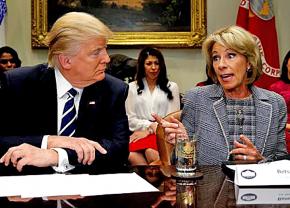The budget disaster in store for our schools
New York City educator and author examines one section of the Trump administration budget: Betsy DeVos' frightening plan to gut the department she runs.
IN A recent op-ed for the Wall Street Journal, Education Secretary Betsy DeVos wrote: "Every decision I make as secretary of education is considered through a single, focused lens: How does this affect an individual student?"
Based on the new education budget that she and her boss Donald Trump are proposing, though, it appears that there are a few million "individual students" that DeVos has overlooked.
According to a summary posted on the White House website on May 23, the Trump-DeVos proposal would cut $9 billion from the federal government's education budget--a 13 percent reduction. A "blueprint" document released a few days earlier outlined a host of specific education programs slated for elimination.
Many commentators predicted a budget this devastating couldn't pass in Congress in its present form. But even if this is just where the bargaining begins, public education is in great danger.
The dynamic duo--DeVos and Trump--are proposing to eliminate outright the $2.4 billion Supporting Effective Instruction State Grants program, which funds teacher training and class size reductions.

Half of this money is used to make class sizes smaller by paying approximately 9,000 teachers' salaries, roughly 70 percent of them in the nation's poorest school districts. I personally have not visited all of these schools, but I am 100 percent certain that individual students go to them, and that many of them benefit from greater individual attention because of the smaller class sizes.
The Trump-DeVos budget would eliminate the 21st Century Community Learning Centers program, which funds before- and after-school programs serving 1.6 million students. That's a lot of individuals. More than 70 percent of these individual students also participate in a free or reduced lunch program.
Documents leaked to the Washington Post apparently reveal further cruel cuts--to adult literacy, arts education, foreign language and college loan forgiveness programs.
BUT NOT everything in the Education Department budget is being cut with the aim of "Making America Great Again."
The proposal "places power in the hands of parents and families to choose schools that are best for their children," the blueprint reads, "by investing an additional $1.4 billion in school choice programs." That's $168 million for more charter schools, $250 million for a new private school choice program, plus a $1 billion increase in Title I funding to incentivize districts to let per-pupil funding "follow the students" to the schools of their choice.
As Jeff Bryant noted at Truth-out, doing violence to the public school system is a logical way to promote "choice."
With larger class sizes, less teacher training, fewer resources for arts and foreign languages and no affordable after-school programs, parents will have no choice but to "choose" to take their individual children out of public schools and seek alternatives via charter schools and voucher plans.
Never mind that charter schools continue to underperform traditional public schools. Never mind that charters have been repeatedly linked to a pattern of increasing racial segregation.
Never mind that voucher initiatives have frequently been rejected by voters in "red" states because they effectively rob funding from public schools. Never mind that "school choice" schemes consistently fail to redistribute resources to the students who need them the most--and usually do the opposite.
As Donna Nevel and Ujju Aggarwal point out in a study of the connection between "choice" and segregation in New York City, "[T]he mechanisms of exclusion have shifted some over time, but the result remains the same: choice for some and exclusion for others."
A lengthy New York Times investigation into New York City's high school choice program concluded that the hierarchy of wealth and privilege was merely reproduced because, "Ultimately, there just are not enough good schools to go around." The Trump-DeVos budget, if approved, would make this problem worse.
JENNIFER BERKSHIRE'S report for Jacobin on the connection between "school choice" and the Christian right suggests that the "individuals" DeVos really has in mind with each decision she makes are her friends who are eager to channel public dollars into the coffers of private schools--especially private religious schools.
But this isn't just a right-wing conspiracy to promote the schools its ideologues prefer. The latest school privatization moves build logically on the arguments and policies put forward by President Barack Obama and his Education Secretary Arne Duncan. "[I]t is Democrats who have pushed to redefine public education in one city after another as an individual parent choice to be exercised in a competitive marketplace, rather than a collective, community good," Berkshire writes.
If the Trump-DeVos budget is devastating news for most students--individually and collectively--there is some good news in the proposal for a few individuals in Washington, D.C.
According to the Washington Post, "Trump is seeking an additional $158 million for salaries and expenses in the Education Department, up 7 percent, money that according to the budget documents would go toward loan-servicing costs, improved information-technology security, auditing and investigations and additional security costs for the secretary. DeVos has contracted with the U.S. Marshals Service to provide security rather than using the in-house security team that guarded previous secretaries."
Looking out at the education landscape her proposed budget would create, DeVos is apparently worried about the safety of one individual in particular: herself.


